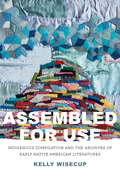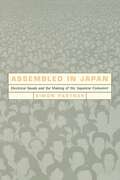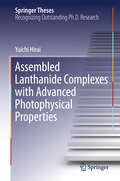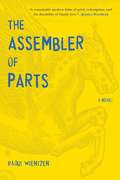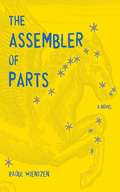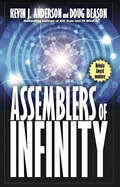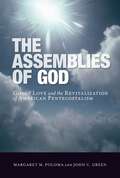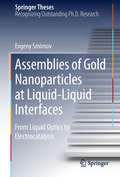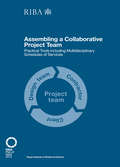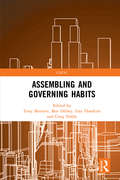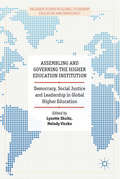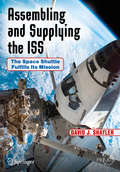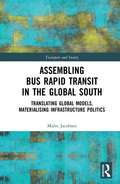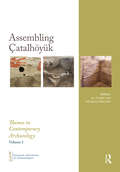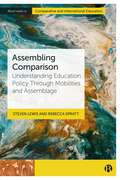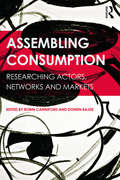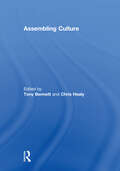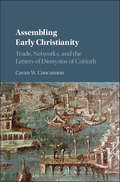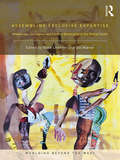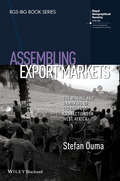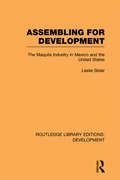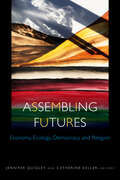- Table View
- List View
Assembled for Use: Indigenous Compilation and the Archives of Early Native American Literatures (The Henry Roe Cloud Series on American Indians and Modernity)
by Kelly WisecupA wide-ranging, multidisciplinary look at Native American literature through non-narrative texts like lists, albums, recipes, and scrapbooks &“An intricate history of Native textual production, use, and circulation that reshapes how we think about relationships between Native materials and settler-colonial collections.&”—Rose Miron, D&’Arcy McNickle Center for American Indian and Indigenous Studies at the Newberry Library Kelly Wisecup offers a sweeping account of early Native American literatures by examining Indigenous compilations: intentionally assembled texts that Native people made by juxtaposing and recontextualizing textual excerpts into new relations and meanings. Experiments in reading and recirculation, Indigenous compilations include Mohegan minister Samson Occom&’s medicinal recipes, the Ojibwe woman Charlotte Johnston&’s poetry scrapbooks, and Abenaki leader Joseph Laurent&’s vocabulary lists. Indigenous compilations proliferated in a period of colonial archive making, and Native writers used compilations to remake the very forms that defined their bodies, belongings, and words as ethnographic evidence. This study enables new understandings of canonical Native writers like William Apess, prominent settler collectors like Thomas Jefferson and Henry Rowe Schoolcraft, and Native people who contributed to compilations but remain absent from literary histories. Long before current conversations about decolonizing archives and museums, Native writers made and circulated compilations to critique colonial archives and foster relations within Indigenous communities.
Assembled in Japan: Electrical Goods and the Making of the Japanese Consumer
by Simon PartnerAssembled in Japan investigates one of the great success stories of the twentieth century: the rise of the Japanese electronics industry. Contrary to mainstream interpretation, Simon Partner discovers that behind the meteoric rise of Sony, Matsushita, Toshiba, and other electrical goods companies was neither the iron hand of Japan's Ministry of International Trade and Industry nor a government-sponsored export-led growth policy, but rather an explosion of domestic consumer demand that began in the 1950s.This powerful consumer boom differed fundamentally from the one under way at the same time in the United States in that it began from widespread poverty and comparatively miserable living conditions. Beginning with a discussion of the prewar origins of the consumer engine that was to take off under the American Occupation, Partner quickly turns his sights on the business leaders, inventors, laborers, and ordinary citizens who participated in the broadly successful effort to create new markets for expensive, unfamiliar new products.Throughout, the author relates these pressure-cooker years in Japan to the key themes of twentieth-century experience worldwide: the role of technology in promoting social change, the rise of mass consumer societies, and the construction of gender in advanced industrial economies.
Assembled Lanthanide Complexes with Advanced Photophysical Properties (Springer Theses)
by Yuichi HiraiNominated as an outstanding PhD thesis by Hokkaido University.<P><P> Expands readers’ understanding by explaining the details of how to synthesize and measure assembled lanthanide complexes.<P> Provides detailed, unprecedented information on microscopy and computation aspects.<P> This thesis provides essential information on the systematic design of assembled lanthanide complexes for functional luminescent materials. It discusses the relationships between assembled structures and photo, thermal, and mechanical properties on the basis of crystallography, spectroscopy, and thermodynamics. The described guidelines for assembled structures will be extremely valuable, both for industrial applications and for readers’ fundamental understanding of solid-state photophysics and materials chemistry.<P> Luminescent lanthanide complexes are promising candidates for lighting devices, lasers, and bio-probes owing to their line-like and long-lived emission arising from characteristic 4f–4f transitions. Low-vibrational and asymmetrical coordination structures around lanthanide ions have been introduced to achieve strong luminescence, using specific organic ligands. Recently, assembled lanthanide complexes including coordination polymers and metal organic frameworks have increasingly attracted attention as a new class of luminescent materials offering thermal stability and color tunability. However, improving the luminescence efficiencies of these compounds remains a challenge, and specific molecular designs to control assembled structures and yield additional physical properties have not been established. The author provides a group of bent-angled bridging ligands to boost photoluminescence efficiency, and successfully introduces for the first time glass formability and strong triboluminescence properties.
The Assembled Parties
by Richard Greenberg"The Assembled Parties is Greenberg's most richly emotional work in years, and the most beautifully detailed."--New York magazine"This tragicomedy shocks us into realizing how hungry we have been for witty and wounded grown-ups who toss off gorgeously written observations without knowing how little we know about what we think we know."--NewsdayMeet the Bascovs, an Upper West Side Jewish family in 1980. In an opulent apartment overlooking Central Park, former movie star Julie and her sister-in-law Faye bring their families together for a traditional holiday dinner on a night when things don't go as planned. Twenty years later, as 2001 approaches, the Bascovs's seemingly picture-perfect life may be about to crumble. An incisive portrait of a family grasping for stability at the dawn of a new millennium, The Assembled Parities premiered on Broadway in 2013 to rave reviews and a Tony Award nomination for Best Play.Richard Greenberg has written two dozen plays in his thirty-year career, including Take Me Out (Tony Award for Best Play, Drama Desk Award, NY Drama Critics Circle Award, Outer Critics Circle Award, Lucille Lortel Award), The Dazzle (Outer Critics Circle Award), Three Days of Rain (L.A. Drama Critics Award, Pulitzer Prize finalist), The American Plan, the book for a musical adaptation of Far From Heaven, and many more. He has received the Oppenheimer Award for a new playwright as well as the first PEN/Laura Pels Award for a playwright in mid-career.
The Assembler of Parts: A Novel
by Raoul WientzenA dual Kirkus Best Fiction and Best Debut Fiction selection, this stunning novel is an emotional fable about love, forgiveness, and what most makes us human.At the outset of this extraordinary first novel, eight-year-old Jess finds herself in heaven reviewing her short life. She is guided in this by a being she calls the Assembler of Parts, and her task seems to be to grasp her life’s meaning. From the moment of her birth, it was obvious that Jess is unlike other children, for she suffers from a syndrome of birth defects that leaves her flawed. But by her very imperfections, she has a unique ability to draw love from-and heal-those around her, from the parents who come together over her to the grandmother whose guilt she assuages, to the family friend she helps reconcile with an angry past.Yet, it is only when she comes to her sudden death-for which her parents are suspected of neglect, unleashing a chain of events beyond her healing-that her sense of her life truly begin to crystallize. And only then does the Assembler’s purpose become clear. With prose that is rich in emotion and eloquence and that distills poetry from the language of medicine and the words for ordinary things, Raoul Wientzen has delivered a novel of rare beauty that speaks to subjects as profound as faith, what makes us human, and the value of a life.Skyhorse Publishing, as well as our Arcade, Yucca, and Good Books imprints, are proud to publish a broad range of books for readers interested in fiction-novels, novellas, political and medical thrillers, comedy, satire, historical fiction, romance, erotic and love stories, mystery, classic literature, folklore and mythology, literary classics including Shakespeare, Dumas, Wilde, Cather, and much more. While not every title we publish becomes a New York Times bestseller or a national bestseller, we are committed to books on subjects that are sometimes overlooked and to authors whose work might not otherwise find a home.
The Assembler of Parts
by Raoul WientzenFrom the start of this extraordinary first novel, eight-year-old Jess finds herself in heaven reviewing her short life. She is guided in this by a being she calls the Assembler of Parts, and her task, as she understands it, is to glean her life's meaning. From birth, it was obvious that she was unlike other children: she was born without thumbs. The Assembler left out other parts too, for she suffers from a syndrome of birth defects that leaves her flawed. But soon it becomes apparent that by her very imperfections she has a unique ability to draw love from--and heal--those around her, from the team of doctors who rally to her care, to the parents who come together over her, to the grandmother whose guilt she assuages, to the family friend whom she helps reconcile with an angry past. With a voice full of wisdom and humor, she tells their stories too. Yet, only when she dies suddenly and her parents are suspected of neglect, unleashing a chain of events beyond her healing, does the meaning of her life come into full focus. And only then does the Assembler's purpose become clear.With prose that is rich in emotion--from laughter to tears to outrage to joyful relief--and an eloquence that distills poetry from the language of medicine and the words for ordinary things, Raoul Wientzen has delivered a novel of rare beauty that speaks to subjects as profound as faith, what makes us human, and the value of a life.
Assemblers of Infinity
by Kevin J. Anderson Doug BeasonEarth&’s thriving lunar colony faces a mysterious, growing threat on the far side of the Moon . . . an alien invasion or nanotechnology run amuck. The crew of Moonbase Columbus makes an amazing discovery on the far side of the Moon—a massive alien structure is erecting itself, built up atom by atom by living machines, microscopically small, intelligent, and unstoppable, consuming everything they touch. The mysterious structure begins to expand and take shape, and its creators begin to multiply. Is this the first strike in an alien invasion from the stars? Is it an attempt at first contact? Or has human nanotechnology experimentation gone awry, triggering an unexpected infestation? As riots rage across a panicked Earth, scientists scramble to learn the truth before humanity&’s home is engulfed by the voracious machines. Praise for Assemblers of Infinity Nebula Award Nominee &“The authors have a fine grasp of character and a slick writing style.&” —Science Fiction Review&“Anderson and Beason are the heavyweight tag-team of hard science fiction!&” —Allen Steele, author of Labyrinth of Night&“Wonderfully vivid, Terrifying, and worse yet . . . realistic!&” —David Brin, author of Startide Rising
The Assemblies of God: Godly Love and the Revitalization of American Pentecostalism
by Margaret M. Poloma John C. GreenThe Assemblies of God (AG) is the ninth largest American and the world’s largest Pentecostal denomination, with over 50 million followers worldwide. The AG embraces a worldview of miracles and mystery that makes“supernatural” experiences, such as speaking in tongues, healing, and prophecy, normal for Christian believers. Ever since it first organized in 1916, however, the “charismata” or “gifts of the Holy Spirit” have felt tension from institutional forces. Over the decades, vital charismatic experiences have been increasingly tamed by rituals, doctrine, and denominational structure. Yet the path towards institutionalization has not been clear-cut. New revivals and direct personal experience of God—the hallmarks of Pentecostalism—continue as an important part of the AG tradition, particularly in the growing number of ethnic congregations in the United States.The Assemblies of God draws on fresh, up-to-date research including quantitative surveys and interviews from twenty-two diverse Assemblies of God congregations to offer a new sociological portrait of the AG for the new millennium. The authors suggest that there is indeed a potential revitalization of the movement in the works within the context of the larger global Pentecostal upswing, and that this revitalization may be spurred by what the authors call “godly love:” the dynamic interaction between divine and human love that enlivens and expands benevolence.The volume provides a wealth of data about how the second-largest American Pentecostal denomination sees itself today, and suggests trends to illuminate where it is headed in the future.
Assemblies of Gold Nanoparticles at Liquid-Liquid Interfaces: From Liquid Optics to Electrocatalysis (Springer Theses)
by Evgeny SmirnovNominated as an outstanding Ph.D. thesis by the École Polytechnique Fédérale de Lausanne, Switzerland.<P><P> Shows the self-assembly of gold nanoparticles into nanoparticles films Investigates the optical, mechanical and electrochemical properties of metal liquid-like droplets.<P> Explores the elctrocatalytic capability of nanoparticles placed at the interface.<P> This book is devoted to various aspects of self-assembly of gold nanoparticles at liquid-liquid interfaces and investigation of their properties. It covers primarily two large fields: (i) self-assembly of nanoparticles and optical properties of these assemblies; and (ii) the role of nanoparticles in redox electrocatalysis at liquid-liquid interfaces. The first part aroused from a long-lasting idea to manipulate adsorption of nanoparticles at liquid-liquid with an external electric field to form 'smart' mirrors and/or filters. Therefore, Chapters 3 to 5 are dedicated to explore fundamental aspects of charged nanoparticles self-assembly and to investigate optical properties (extinction and reflectance) in a through manner. Novel tetrathiafulvalene (TTF)-assisted method leads to self-assembly of nanoparticles into cm-scale nanofilms or, so-called, metal liquid-like droplets (MeLLDs) with remarkable optical properties. The second part (Chapters 6 to 8) clarifies the role of nanoparticles in interfacial electron transfer reactions. They demonstrate how nanoparticles are charged and discharged upon equilibration of Fermi levels with redox couples in solution and how it can be used to perform HER and ORR. Finally, Chapter 9 gives a perspective outlook, including applications of suggested methods in fast, one-step preparation of colloidosomes, SERS substrates as well as pioneer studies on so-called Marangony-type shutters drive by the electric field.
Assembling a Collaborative Project Team: Practical tools including Multidisciplinary Schedules of Services
by Dale SinclairContemporary construction practice presents a shift in emphasis from thinking about the design team in isolation, to considering the project team as a collaborative whole: client, design team, and contractor. This approach requires greater consideration of how the project team is procured and assembled – and Assembling a Collaborative Project Team provides a range of in-depth and invaluable methods for ensuring that this essential task is carried out effectively. It will bring a range of benefits to any project – from facilitating BIM-ready teams, to better construction programming, and reducing risk through ensuring a watertight contractual framework. Many of the methods presented here are likely to become ingrained in the way all projects are coordinated. It shows that the best way of assembling a collaborative team is by establishing the team at the outset in manner that ensures that each party is fully aware of what they need to do and when, and by agreeing how this will be achieved.
Assembling and Governing Habits (CRESC)
by Tony BennettThe increasing significance of managing or changing habits is evident across a range of pressing contemporary issues: climate change, waste management, travel practices, and crowd control. Assembling and Governing Habits engages with the diverse ways in which habits are governed through the knowledge practices and technologies that have been brought to bear on them. The volume addresses three main concerns. The first focuses on how the habit discourses proposed by a range of disciplines have informed the ways in which different forms of expertise have shaped the ways in which habits have been managed or changed to bring about specific social objectives. The second concerns the ways in which habits are acted on as aspects of infrastructures which constitute the interfaces through which technical systems, human conducts and environments are acted on simultaneously. The third concerns the specific ways in which habit discourses and habit infrastructures are brought together in the regulation of ‘city habits’: that is, habits which have specific qualities arising out of the specific conditions – the rhythms and densities – of urban life and ones which, in the wake of the COVID-19 pandemic, have been profoundly disrupted. Written in a clear and direct style, the book will appeal to students and scholars with an interest in cultural studies, sociology, cultural geography, history of the sciences, and posthuman studies.
Assembling and Governing the Higher Education Institution: Democracy, Social Justice and Leadership in Global Higher Education (Palgrave Studies in Global Citizenship Education and Democracy)
by Lynette Shultz Melody ViczkoThis book emphasizes the inherently democratic nature of education; from those who practice in higher education institutions and are involved in decision-making, to those questioning the methods of reform processes in those institutions. As they are faced with increasing pressures to restructure and change their organizations in line with global institutional demands the foundations upon which their leadership and governance are based are called into question. This book takes a critical approach to understanding higher education leadership and governance. The overarching questions asked in this book are: how has higher education come to be assembled in contemporary governance practices within the context of global demands for reform and how are issues of justice being taken up as part of and in resistance to this assemblage?
Assembling and Managing Project Teams: Realizing Disruptive Potential
by Joseph V. Sinfield Scott D. Anthony Mark W. Johnson Elizabeth J. AltmanOne of the greatest challenges facing managers seeking to create new growth businesses is assembling and managing teams charged with creating new growth. This chapter provides guidelines for senior managers to set up a team for success.
Assembling and Supplying the ISS: The Space Shuttle Fulfills Its Mission (Springer Praxis Books)
by David J. ShaylerThis book tells the story of the International Space Station from the perspective of the space shuttle's involvement in how the assembly and re-supply of the station evolved. It captures how the intricate and wide-reaching infrastructure required by each mission was managed and provides a comprehensive view of the relationship between the shuttle and ISS. The success in assembling the ISS over a period of 13 years came after gaining experience by sending the space shuttle to the Russian Mir space station in a three-year period during the second half of the 1990s, and after years of detailed study and evaluation. This book reviews those developments and how years of planning, hopes and dreams were turned into reality between 1995 and 2011. It provides detailed reviews of the space shuttle missions at space stations, including how the skills were developed to achieve these missions, what happened on those flights, and how lessons learned from one mission were applied to subsequent operations. Note that no mission failed in its main objective across nine Mir dockings and one rendezvous mission and 37 shuttle flights to the ISS. The smoothness and reliability of actual station operations masks the years of hard work that went into each mission both in space and on the ground. Using first-hand research, personal interviews and contemporary sources, an alternative story of the space shuttle is portrayed.
Assembling Bus Rapid Transit in the Global South: Translating Global Models, Materialising Infrastructure Politics (Transport and Society)
by Malve JacobsenThis book explores the mobile ethnography of Dar es Salaam, where consultants and politicians have planned and implemented a bus rapid transit (BRT) system for two decades. It analyses the dual processes of assembling BRT in the Tanzanian metropolis and establishing BRT as a policy model of and for the Global South. The book elucidates how policy models are constructed and circulated around the globe and depicts the processes by which they are translated between, and materialise within, specific contexts. It presents the case of BRT to demonstrate how technocrats shape these processes through persuasive work aimed at disseminating and stabilising this transport model, and how local actors influence its adaptation in Dar es Salaam. The book adopts a ‘double mobility’ approach to show how this ethnography follows travelling consultants, circulating policies and moving buses to explore the fluidity of the BRT model. Linking key debates in policy mobility studies and Science and Technology Studies, enriched with postcolonial perspectives and geographies of transport and infrastructure, it offers new insights into the technopolitics of planning and implementing infrastructure systems. This book will appeal to academics and students of human geography, transport studies, science and technology studies, and African and development studies interested in the technopolitics of transport planning.
Assembling Çatalhöyük (Themes in Contemporary Archaeology)
by Ian Hodder Arkadiusz Marciniak"Assembling ?�alh?�??k, like archaeological remains, can be read in a number of ways. At one level the volume reports on the exciting new discoveries and advances that are being made in the understanding of the 9000 year-old Neolithic site of ?�alh?�??k. The site has long been central to debates about early village societies and the formation of ��mega-sites��in the Middle East. The current long-term project has made many advances in our understanding of the site that impact our wider understanding of the Neolithic and its spread into Europe from the Middle East. These advances concern use of the environment, climate change, subsistence practices, social and economic organization, the role of religion, ritual and symbolism. At another level, the volume reports on methodological advances that have been made by team members, including the development of reflexive methods, paperless recording on site, the integrated use of 3D visualization, and interactive archives. The long-term nature of the project allows these various innovations to be evaluated and critiqued. In particular, the volume includes analyses of the social networks that underpin the assembling of data, and documents the complex ways in which arguments are built within quickly transforming alliances and allegiances within the team. In particular, the volume explores how close inter-disciplinarity, and the assembling of different forms of data from different sub-disciplines, allow the weaving together of information into robust, distributed arguments."
Assembling Comparison: Understanding Education Policy through Mobilities and Assemblage
by Steven Lewis Rebecca SprattThis book combines assemblage theory and policy mobilities to inform the study of comparative and international education (CIE), focusing on education policy and how such policy moves are enacted. These approaches challenge taken-for granted and universalizing concepts in policy research and policy work in CIE – such as the nation-state, policy making/policy enactment, global/local, Global North/Global South – and highlight how policy is contingent on emerging through complex relations between people and places. Using illustrative cases drawn from research and practice in CIE and education development, the book demonstrates how these ideas can be used in the analysis of policy and the application of this approach in real life.
Assembling Consumption: Researching actors, networks and markets
by Domen Bajde Robin CannifordAssembling Consumption marks a definitive step in the institutionalisation of qualitative business research. By gathering leading scholars and educators who study markets, marketing and consumption through the lenses of philosophy, sociology and anthropology, this book clarifies and applies the investigative tools offered by assemblage theory, actor-network theory and non-representational theory. Clear theoretical explanation and methodological innovation, alongside empirical applications of these emerging frameworks will offer readers new and refreshing perspectives on consumer culture and market societies. This is an essential reading for both seasoned scholars and advanced students of markets, economies and social forms of consumption.
Assembling Culture
by Tony Bennett and Chris HealyIf the social does not exist as a special domain but, in Bruno Latour’s words, as ‘a peculiar movement of re-association and reassembling’, what implications does this have for how ‘the cultural’ might best be conceived? What new ways of thinking the relations between culture, the economy and the social might be developed by pursuing such lines of inquiry? And what are the implications for the relations between culture and politics? Contributors draw on a range of theoretical perspectives, including those associated with Deleuze and Guattari, Foucault, Law and Haraway, in order to focus on the roles of different forms of expertise and knowledge in producing cultural assemblages. What expertise is necessary to produce indigenous citizens? How does craniometry assemble the head? What kinds of knowledge were required to create markets for life insurance? These and other questions are pursued in this collection through a challenging array of papers concerned with cultural assemblages as diverse as brands and populations, bottled water and mobile television.
Assembling Early Christianity: Trade, Networks, and the Letters of Dionysios of Corinth
by Concannon Cavan W.In this book, Cavan W. Concannon explores the growth and development of Christianity in the second century. He focuses on Dionysios of Corinth, an early Christian bishop who worked to build a network of churches along trade routes in the eastern Mediterranean. Using archaeological evidence, and analysing Dionysios' fragmentary letter collection, Concannon shows how various networks and collectives assembled together, and how various Christianities emerged and coexisted as a result of tenuous and shifting networks. Dionysios' story also overlaps with key early Christian debates, notably issues of celibacy, marriage, re-admission of sinners, Roman persecution, and the economic and political interdependence of churches, which are also explored in this study. Concannon's volume thus offers new insights into a fluid, emergent Christianity at a pivotal moment of its evolution.
Assembling Exclusive Expertise: Knowledge, Ignorance and Conflict Resolution in the Global South (Worlding Beyond the West)
by Anna Leander Ole WaeverThis book looks at the worlding of the Global South in the process of assembling conflict resolution expertise. Anna Leander, Ole Wæver and their contributors pursue this ambition by following the experts, institutions, databases and creative expressions that are assembled into conflict resolution expertise in the Global South. Expertise shapes how conflicts in the Global South are understood and consequently dealt with. Yet, expertise is always and necessarily exclusive. The exclusivity of expertise refers both to the fashionable, the sophisticated and what counts, and also to the exclusion of some people or views. Assembled from a wealth of competing knowledges expertise is always both knowledgeable and ignorant. The ambition of the volume is to explore how this exclusive expertise is assembled and in what ways it is therefore knowledgeable and ignorant of knowledges in/of the Global South. This work will be of significant interest to advanced students and scholars of conflict resolution, peace research, mediation and international relations and scholars of expertise.
Assembling Export Markets: The Making and Unmaking of Global Food Connections in West Africa (RGS-IBG Book Series)
by Stefan OumaAssembling Export Markets explores the new ‘frontier regions’ of the global fresh produce market that has emerged in Ghana over the past decade. Represents a major and empirically rich contribution to the emerging field of the social studies of economization and marketization Offers one of the first ethnographic accounts on the making of global commodity chains ‘from below’ Denaturalizes global markets by unpacking their local engagement, materially entangled construction, need for maintenance, and fragile character Offers a trans-disciplinary engagement with the construction and extension of market relations in two frontier regions of global capitalism Critically examines the opportunities and risks for firms and farms in Ghana entering global fresh produce markets
Assembling Financialisation: Local Actors and the Making of Agricultural Investment
by Zannie LangfordFarmers, Indigenous organisations, government and private-sector intermediaries from remote Northern Australia often negotiate with private finance capital to gain funds for agricultural development.The concept of financialisation is used to explore the drivers and effects of agrifood restructuring in the area, while assemblage theory is applied to position local actors as potential sites of power in negotiating connections between local spaces and global finance. This book demonstrates that while financialisation is a useful signifier of patterns of global change, it is assembled by a diverse range of often contradictory work.
Assembling for Development: The Maquila Industry in Mexico and the United States (Routledge Library Editions: Development #No. 5)
by Leslie SklairFirst published in 1989, this book focuses upon the phenomenon of export-led industrialisation fuelled by foreign investment and technology. He concentrates on Mexico, where US companies have been taking advantage of inexpensive labour to establish "maquila" factories that assemble US parts for export. Through this detailed study of the maquila industry, Sklair charts the progress from the political imperialism of colonial days to the economic imperialism of today.
Assembling Futures: Economy, Ecology, Democracy, and Religion (Transdisciplinary Theological Colloquia)
by Jennifer Quigley and Catherine KellerTransdisciplinary insights at the intersection of religion, democracy, ecology, and economyWhat is the relationship of religion to economy, ecology, and democracy? In our fraught moment, what critical questions of religion may help to assembly democratic processes, ecosystems, and economic structures differently? What possible futures might emerge from transdisciplinary work across these traditionally siloed scholarly areas of interest?The essays in Assembling Futures reflect scholarly conversations among historians, political scientists, theologians, biblical studies scholars, and scholars of religion that transgress disciplinary boundaries to consider urgent matters expressive of the values, practices, and questions that shape human existence. Each essay recognizes urgent imbrications of the global economy, multinational politics, and the materiality of ecological entanglements in assembling still possible futures for the earth. Precisely in their diversity of disciplinary starting points and ethical styles, the essays that follow enact their intersectional forcefield even more vibrantly.
